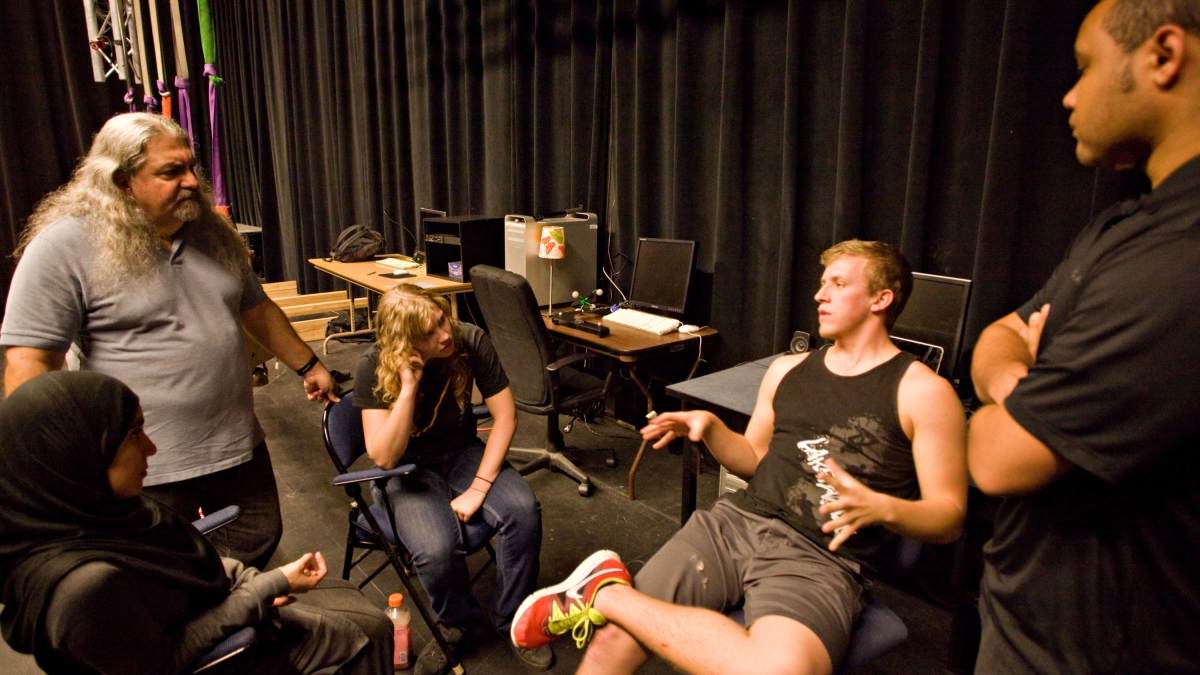Hands-on Digital Culture Showcase offers glimpse of future

Students enrolled in the BA in Digital Culture program in the ASU School of Arts, Media + Engineering are featured in a hands-on Digital Culture Showcase, March 1-2, in Stauffer Hall B on the Tempe campus. The showcase is part of Emerge 2013, a wide-ranging, cross-disciplinary symposium that invites artists, scientists, engineers and humanists to redesign the future.
Interactive installations range from multiplayer mobile games called Scatter, to a dance performance that through technology allows the dancer to also be the musician, conductor and choreographer. Other installations plunge visitors in sensory-rich worlds where they engage in sword fights and invite them to enter an online search for the brightest students in science and engineering eligible for an internship working with professionals on actual projects.
The student projects reflect the Herberger Institute for Design and the Arts Digital Culture program’s emphasis on providing its students with the tools to create their dreams in an environment rich with equipment, a collaborative spirit and a flexible but rigorous curriculum.
It was the program’s innovative approach that attracted Donald Marinelli, co-founder with the late Randy Pausch of Carnegie Mellon University’s Entertainment Technology Center, who accepted a visiting professor position in the School of Arts, Media and Engineering to help guide students in developing their projects for the upcoming showcase.
“Throughout my entire academic career I’ve been increasingly frustrated by the atrophy that I see in traditional undergraduate education. And I kept thinking what’s going to be the reading, writing and arithmetic for 21st century digital natives? When I encountered the digital culture undergraduate major when I was here last February as part of a review team I just thought, ‘Wow. That’s it.’ Because you have young people who are bringing so much more to the table now in terms of facility with technology and in terms of the knowledge of what technology has opened up,” said Marinelli. “What’s amazing is this is out of the realm of the theoretical. It’s real world and it will have an immediate impact.”
In the case of students Justin Boord-Balash and Caleb Kilian their project, "Phonic Vibrations," fuses the physical and digital realms of art and technology and recent studies that reveal energy, unlike motion, is always present. “This is an experience that allows the dancer to take control of composition, structure, movement, all while creating a story-lined soundscape,” Boord-Balash and Kilian said. “How she moves, the speed of movement, as well as where she moves in the space all impact the timbre and parameters of the sounds created. No two performances will ever be the same.”
In addition to the showcase, 15 students will also present their ideas in the Digital Culture Pitch Competition scheduled beginning at 4 p.m., March 1, in Stauffer B on the Tempe campus.
The competition is also part of the Digital Culture curriculum that underscores the importance of creators being able to articulate the story and meaning behind their creation, said Patrick Koppula, co-founder of three digital culture startups, FFWD, iLike and GarageBand, and visiting professor at the ASU School of Arts, Media + Engineering. Koppula has guided students through refining their presentations, which will be given to a panel of three judges representing the software, hardware and storytelling (film, arts, museums) aspects of the digital culture marketplace. The pitches – each represent a student’s senior year capstone project – receive money from the school for materials and resources based on the judges’ rankings, with the highest–ranking project receiving the most money.
Koppula too has high praise for the ASU Digital Culture degree program. “The students won’t have at their disposal access to these kinds of resources until they are five to 10 years into their careers. It’s amazing to me what they have available to them,” he said.
He cites the practical, real-world nature of the pitch project at this stage in a student’s education as another example of the program’s strength. The experience of having to capture another person’s willingness to invest in your project whether it’s their time, money or willingness to open the proverbial door of opportunity is critical to a student’s growth and ultimate success in the marketplace, according to Koppula.
“What’s implicit in a pitch is the understanding that you can’t do it by yourself. You need somebody else to buy into the venture,” Koppula said. “This experience lets them see how they can seize an opportunity that lets them stretch beyond all that they thought they were capable of doing.”
For more information about the showcase, which has new hours from noon to 2 p.m. and 4 to 7 p.m., March 1-2, visit Digital Culture Showcase. For more information about the Digital Culture undergraduate degree program visit digitalculture.asu.edu.